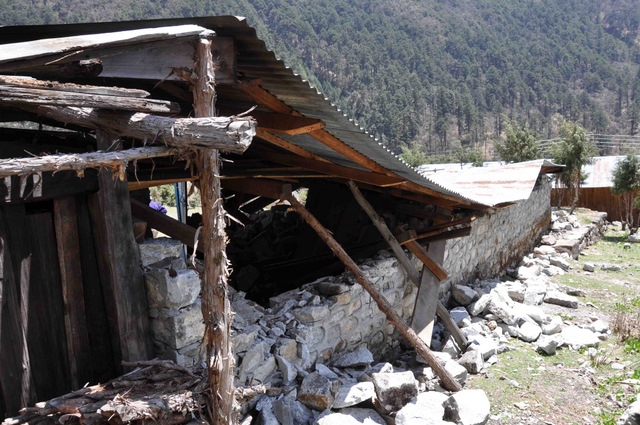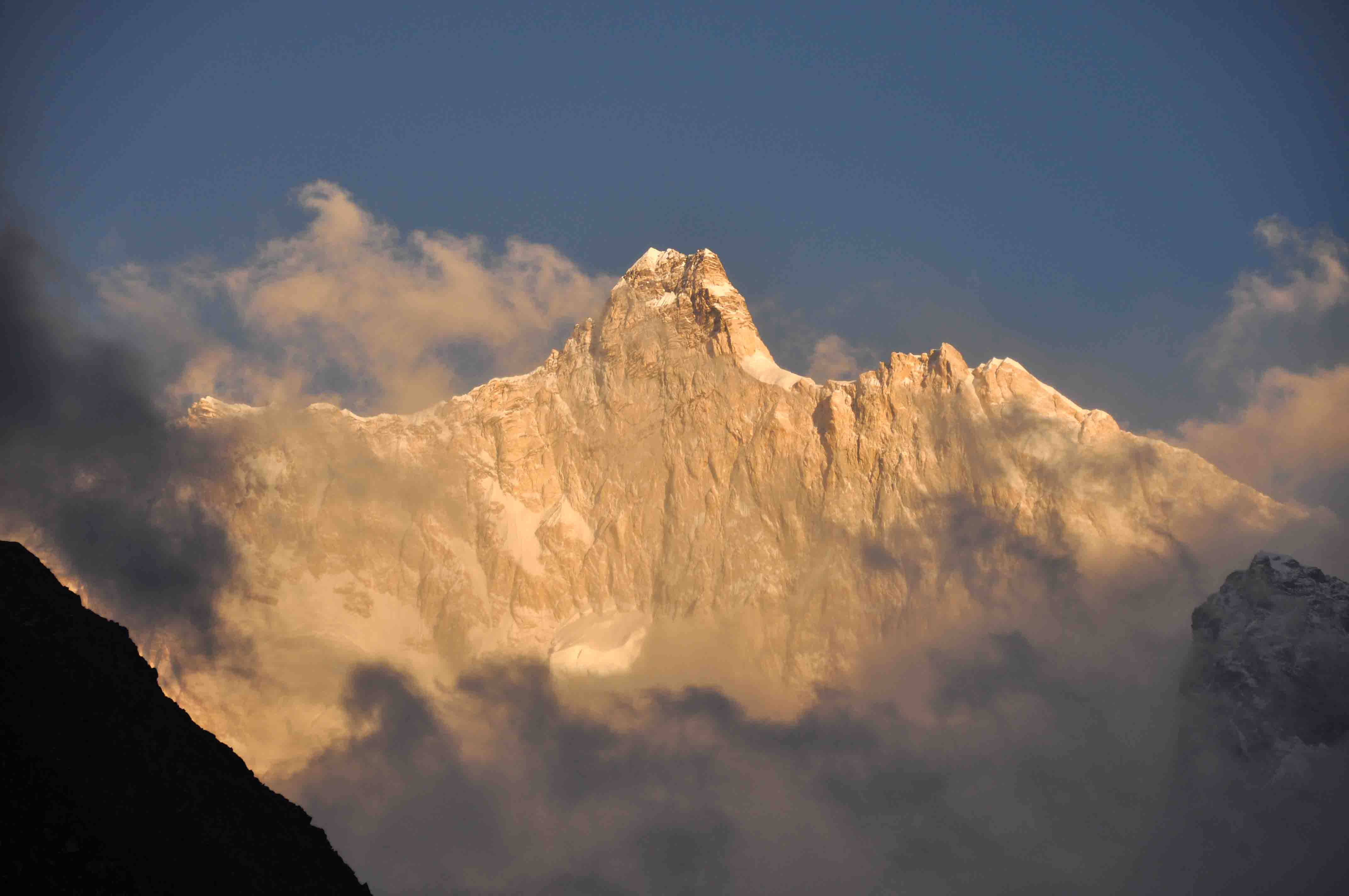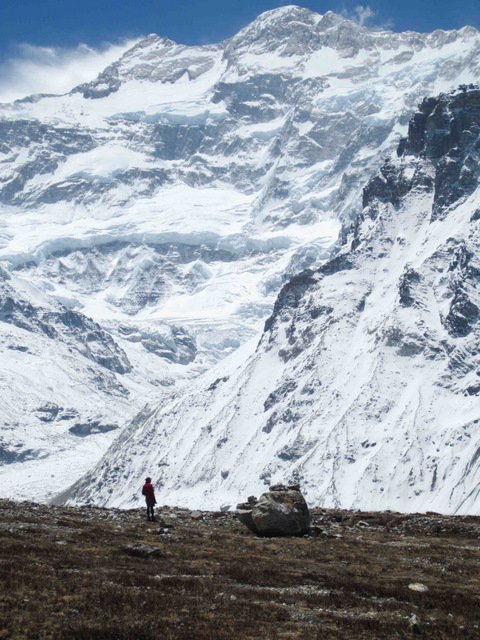
TREK REPORT 2012
> Home > Volunteer treks > Trek report 2012
Surveying the earthquake damage

Geoff, Rob, Donna, Claire, Rick and Lesley about to leave Sinam
Another KSP volunteer trek to the Kangchenjunga region got under way just after Easter 2012 when five Kiwis joined Rob to holiday in this remote part of Nepal.
Our key interest was assessing the damage from last September’s large earthquake in Eastern Nepal. The earthquake, measuring 6.9 on the Richter scale, was centred
on the Sikkim-Nepalese border close to the area we were visiting. The main purpose of the trip was to assess the damage to the KSP schools and to repair them if possible.
The Ghunsa School was slightly damaged, but the Folay School was virtually levelled by the quake. Luckily, the earthquake occurred at night, so no children were killed or
injured by the collapsed school.
Getting started
We flew out of Kathmandu on 9 April on Yeti Airlines to Bhadrapur. A large jeep, plus driver and boy, awaited us there for the road journey to Sinam, our starting point.
Rob was excited that the road had been extended as far as Sinam. In 2009 they had to walk from Tharpu, adding an extra half-day. The road was pretty good until we got off the
tar seal, but after that heavy overnight rain soon turned the road into a 4WD adventure.
At Sinam we met the rest of our party, which included three guides, several kitchen staff, and porters. They had travelled by bus for two days from Kathmandu, bringing with
them the gear and most of the food we would need for the next 25 days. At this point our party for the walk in numbered 23.
We had a great start to the trip – the sun was shining and a delicious meal awaited us at our first campsite. MB was reputed to be a great cook and we were not disappointed
with our first meal of sliced white bread, fried tomatoes, smoked sausage, watermelon, and tea. We dined in style with a tablecloth and napkins. This was the pattern of meals
to come throughout the trek, even in rain, snow and at high altitude.
To Tellok and beyond – checking the health posts
Our initial destination was Tellok, a substantial village at just over 1000m altitude. A day was set aside here for Rob to try to fix the vaccine fridge. En route Rob, Geoff,
Claire and a porter boy trekked across the valley to the Sablakhu health post to install a new set of batteries for the vaccine fridge. There we met Rita, the midwife, who
showed us her clinic.
It was a lazy next day at Tellok for most of us except Rob, Geoff and our cooks. The vaccine fridge was not repairable, despite Rob’s best efforts. The cooks had been busy and
served us the most delicious apple pie for dessert that night. We employed the very skilful village tailor to make a skirt for Donna, a neck shade for Rob’s bright orange cap
and to make Rick’s overly large trousers a better fit. Now we were dressed to go trekking!
The next morning we descended through terraced fields and lush cardamom groves below Tellok to cross the river before beginning a hot climb to Mamangkhe. On this part of the
trail we had our first clear views of the snow-covered peak of Jannu. We stopped for cold beers at a very pretty village called Phonge Phonge (or Fun Fun) to cool off. That night’s
camp in Mamangkhe was very wet, but our tents remained dry and comfortable.
A new health post in Mamangkhe was being built, replacing the old one on the outskirts of the village. Rob and Geoff put in some lighting and installed a replacement battery
in anticipation of a new vaccine fridge sometime in the future.
It was a pleasant walk to our next stop at the Sherpa village of Yamphudin at 2080m. Again the afternoon rains thundered down and we were happy to stay in the comfy teahouse
rather have another wet camp.

New healthpost in Mamankhe
Gaining altitude – Yamphudin to Yalung
By day five of our trek we were getting higher and closer to the mountains. Jannu dominated the views. We had a demanding climb that day to a pass called Lasiya Bangyang at
just over 3300m. Just as we got there a nasty hailstorm hit so we sheltered in the only teahouse to wait out the bad weather. When it didn’t abate we camped there in rather wet,
chilly conditions. The next morning was clear and the ground was completely white like snow, and extremely icy. It was tricky walking from the saddle and our guides cut steps in
the ice to make sure that we and the porters would travel safely. Incredibly, some of our porters were only wearing jandals or light sandshoes.
The rhododendron bushes were in flower now so it was pleasant walking amongst them and past the grazing yaks on the open pastures. We followed the thundering Simbuwa Khola for
several hours, climbing steadily to a hamlet called Anda Phedi for an overnight stop. As we got higher and higher our walking pace slowed and we were conscious of the need to
watch how we were acclimatising.
We opted for a high camp for the next two nights at Yalung Bara, at over 4200m. The landscape was barren and it was much colder and there was little shelter for our kitchen
staff and porters. Some of us were feeling the effects of the altitude so three rested while Rob, Geoff, Rick and GB walked to Oktang. Oktang is close to the South Kangchenjunga
Base Camp and so the views of Kangchenjunga and surrounding mountains are stunning. Lucky for our trekkers, the weather was mostly clear that day.

GB and Rob at Oktang, 4700m on the south side of Kangchenjunga.
Over Mirgin La and a stop in Ghunsa
A quick assessment of the school in Ghunsa revealed only minor damage to the rock walls and a leaking roof. Rob had arranged for a stonemason and he was able to fix the crumbled
walls. Rick, Geoff and GB repaired the leaking roof using recycled ridging iron from the Folay School. Rick noted that the whole roof would need replacing within the
next 18 months.
Donna, our early childhood expert, visited the pre-school in Ghunsa. We had varying reports of how often the pre-school was open and it was closed when we visited. The
teacher opened the school especially for Donna’s visit. Donna spent several hours there observing and joining in singing and play with the children.
On his last visit 18 months ago, Rob had told the village committee that funding for the pre-school teacher would not continue in the future. Rob met the village
committee again and confirmed that he would be making the last salary payment to the teacher this trip. Rob explained that KSP would continue to maintain the pre-school
building and keep funding the health worker (Tenzing) and the midwife (Lamu).
The Ghunsa people had not really believed that the funding would stop as they couldn’t see how the pre-school might continue without a paid teacher. Rob’s suggestion of
using a roster of parents to run the pre-school on a volunteer system did not fit with their understanding or expectations. This approach was also suggested by Doreen Launder
in 2010, but got no traction then. We noticed that there were no women at the meeting. Maybe at the next visit to Ghunsa we should try to talk directly with the women to explore
their views and whether they could run the pre-school themselves.
Ghunsa School
We saw cardamom being harvested (I had no idea the ‘seeds’ come from nodules, which are taken from the roots of the plant then smoked and dried); “simpati” oil being extracted
in a Ghunsa still from the foliage of a mountain shrub for its perfume and medicinal properties; and aromatic juniper being burnt as incense in little outdoor shrines and also gathered
wholesale for fuel. (Always there are issues of sustainability to worry about.)
We saw huge pitsawn planks of amazing quality, cheese being made from the milk of the yak-cow cross common at the lower altitudes, penstock sections and kilometres
of power cable being carried in on the backs of porters, and a beautiful and very efficient water race several kilometres long servicing the small hydro station at
Ghunsa.
We saw monkeys in trees by the river, heard a few birds (but as in New Zealand’s national parks, not as many as hoped for), and after a brief encounter with an Auckland Zoo
researcher(!) on our way out of Mamankhe, we managed to spot several patches of red panda scat on the track! We occasionally had to step aside for yak trains, well
advertised with bells, and at one stage for horses and mules, after we’d recently climbed a long ladder, which puzzled us.
Several of us were looking forward to seeing the weaving of, and purchasing, carpets at Folay, where we’d heard they were still made with more traditional Tibetan
designs and colours than those generally available in Kathmandu. We arrived in Folay in the late afternoon on our way back down (all was holiday-shut on the way up),
so were a little pressed for time, but there seemed to be only two houses where the women still weave, and one of those ladies was getting old and had probably made
her last significant carpet. So we didn’t see any weaving in action, but we did buy one of the older woman’s carpets. As the pre-schools were initially welcomed as
baby-sitting while mothers wove, we wonder what the women do now with their child-free time.
Folay School
A quick walk to Folay the next day soon confirmed that two of the three Folay School buildings had been completely destroyed by the earthquake and the third building suffered
major damage. The children were attending a temporary school made from tarpaulins stretched over frames of tree saplings. The villagers were clearly committed to keeping
their children in school but the temporary arrangement would not be suitable in the coming monsoon.
It was obvious that the Folay School would need to be rebuilt. We were not in a position to tackle that on this trip and instead had a working bee with the Folay villagers
to salvage any re-usable materials for the future. It was a real team effort the day we dismantled the school. We had a large turnout of men and women from the village who
together with our Nepalese staff, plus Rick and Geoff, soon had the job done.

One of the collapsed school buildings at Folay
Rick suggested the replacement school could be built as a wood framed building, clad in corrugated iron on the outside, with see-through roof panels and insulation in the
walls. He thought this style of construction would offer improved warmth and light for the children and teachers, and more importantly, better seismic resistance. We discussed
these ideas with the village and they were keen to have a new school as soon as possible and one that was safer and warmer. The villagers told us they could not do this by
themselves and asked KSP to help. Rob said KSP would try to help but he couldn’t provide a firm commitment without fundraising and finding suitable builders to come to Nepal
from New Zealand.
Later, we met Raj Limbu, the Folay school teacher and a stonemason in Lelep. They had been given a small sum of money by the Nepalese Government to rebuild the school.
The stonemason thought he might be able to rebuild at least one school building in stone if he used some of the recycled materials for roofing, doors and windows. In the
short term this was promising for the Folay village. A full rebuild of the school would take time to plan and would need a different approach to ensure that the school is much
safer in the event of further earthquakes.

Dismantling collapsed school building and salvaging timber
Healthcare
The main issue for the health post in Ghunsa was Tenzing’s lack of access to the free list of medicines and vaccines routinely available in Taplejung. She
could only buy commercial medicines that the villagers could not afford. We were planning to try to resolve this when we got to Taplejung but coincidentally a group of doctors
from Taplejung Hospital visited Ghunsa while we were there. The doctors agreed that Tenzing could have paracetamol and some antibiotics but said she was not qualified to use the
full range of medicines and vaccines unless she did further training (of at least 18 months). This poses a dilemma for the Ghunsa people as Tenzing cannot offer the full
primary care they need. The visiting clinic from Taplejung comes only every two to three years.
Claire, Lesley, and Donna visited Lamu the midwife to pay her wages and find out how her work in the surrounding villages had been going over the past 18 months. Lamu reported
delivering four healthy babies in the past year and providing contraception and maternal education to women in Ghunsa, Folay, and Gyabla.
To Pang Pema (North Base Camp)
After our time in Ghunsa and Folay we were keen to push on into the mountains for the highlight of our trek – the walk to Pang Pema. We walked for two days alongside the
Ghunsa Khola, stopping first in Kambachen and then Lhonak. We noticed a lot of large boulders dotting the trail – clear signs of the September earthquake. We didn’t waste any
time crossing the big slip just before Kambachen in case of rockfall. It was rough travel for our porters, the kitchen staff and our two laden yaks.

Sunset on Jannu from below Kambachen
Lhonak was just a few huts in a big open grassy flat, surrounded by towering mountains. At 4764m, we were right in amongst the big Himalayan peaks and as Rob rightly pointed
out the top of Kangchenjunga was still another 3800m above us!
The night in Lhonak was to be our coolest so far, and our early start to Pang Pema was uncomfortably cold. Donna had not had a good night owing to the altitude, so she stayed behind.
While the walk to Pang Pema was not steep or difficult, our progress was slow as we needed frequent rests. In the sparkling sun we reached the open pastures of Pang Pema and had
clear views of Kangchenjunga, Wedge Peak and other unnamed beauties.

North face of Kangchenjunga from Pangpema (5200m)
Turnaround point and homeward bound
On 27 April we left Lhonak feeling exhilarated. The downhill journey was easier on the breath but the travel was still rough. It was hard going for Lesley and Claire, who each
had some uncomfortable sprains and strains. We rested up in Folay for a day to work on the school. It was a longish day from Folay to Amjilissa, particularly for
Claire and Lesley.
The 600m descent from Amjalissa to the bridge across the Ghunsa Khola was hot, and most of us washed our hair while waiting for tea at Solima. Just below the teahouse is a
bamboo schoolhouse built with money raised by an enterprising trekking guide. As 10am approached, a cluster of kids appeared from houses high above and the teacher arrived
from Lelep, 2 hours away. It was encouraging to see such a simple but effective act of local philanthropy in action.

Bamboo schoolhouse at Solima
Next stop was Lelep, situated high above the confluence of the Tamor River (from Tibet), the Ghunsa Khola, and the Simbawa Khola. Lelep has fertile south facing fields and
a large school with 250 students, and with recent bridge additions it is now on the main trail to Ghunsa. KSP helped build a girls’ dormitory at the school and provided the
vaccine fridge for the health clinic and solar lighting for the Gompa. Rob and Geoff did some routine maintenance at the health clinic, checking the batteries and vaccine
fridge, and installing some new lighting.
Over the next day and a half we completed our walk out, taking the time to savour these last few days. We stopped for tea whenever we felt like it. Our last camp was in
Mitlung, a pretty village above the Tamor River. A big walk up in the heat to the town of Taplejung completed the trek. We paid and farewelled our Nepalese staff and
jumped in our jeep for the road trip back to Ilam. Rob was incredulous that what only 18 months ago was a rutted muddy track is now a paved highway! The next day we drove on
to Bhadrapur for our flight to Kathmandu. Only 9 hours drive now separates Taplejung from the Terai!
We arrived back in Kathmandu on Friday, 4 May, right on schedule!

Chorten Kora procession crossing Ghunsa river bridge



